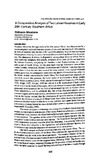A comparative analysis of two labour reserves in early 20th century Southern Africa

View/
Date
2003Author
Ntsabane, T.
Publisher
Pula: Botswana Journal of African StudiesType
Published ArticleMetadata
Show full item recordAbstract
Southern Africa has through much of its 20th century history been characterised by a
centre~periphery regional economic system. At the centre has been South Africa(minus
its African reserves) and the rest of the region the periphery. Key has been the migrant
labour system whereby the centre has been able to extract cheap labour from its periphery. The cheapness, however, is disputed by among others Burawoy (1976). The labour- supplying periphery was actually composed of two tiers. On the one hand were
the African Reserves, comprising the Transkei, Ciskei, Bophuthatswana, etc., politically
a part of South Africa. On the other hand were the independent states of Botswana,
Lesotho, Swaziland, Malawi, Mozambique and Zimbabwe
